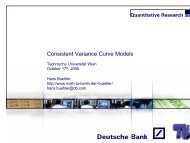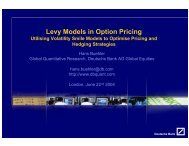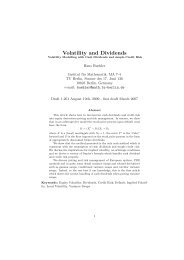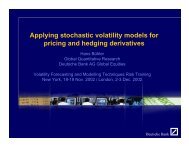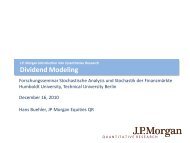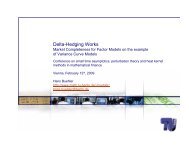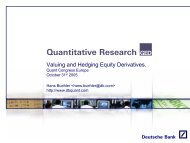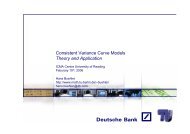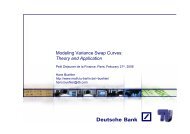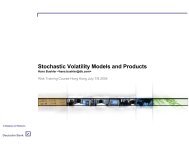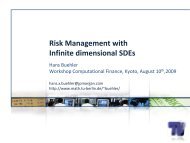Risk 1 - Hans Buehler
Risk 1 - Hans Buehler
Risk 1 - Hans Buehler
Create successful ePaper yourself
Turn your PDF publications into a flip-book with our unique Google optimized e-Paper software.
Equity Derivatives Teach-In<br />
Modeling <strong>Risk</strong><br />
Dr. <strong>Hans</strong> <strong>Buehler</strong>, Head of EDG QR Asia<br />
Singapore, August 1 st , 2009<br />
hans.x.buehler@jpmorgan.com<br />
0
English_General<br />
[ P R E S E N T A T I O N T I T L E ]<br />
This presentation was prepared exclusively for the benefit and internal use of the J.P. Morgan client to whom it is directly addressed and delivered (including such<br />
client’s subsidiaries, the ―Company‖) in order to assist the Company in evaluating, on a preliminary basis, the feasibility of a possible transaction or transactions<br />
and does not carry any right of publication or disclosure, in whole or in part, to any other party. This presentation is for discussion purposes only and is<br />
incomplete without reference to, and should be viewed solely in conjunction with, the oral briefing provided by J.P. Morgan. Neither this presentation nor any of<br />
its contents may be disclosed or used for any other purpose without the prior written consent of J.P. Morgan.<br />
The information in this presentation is based upon any management forecasts supplied to us and reflects prevailing conditions and our views as of this date, all of<br />
which are accordingly subject to change. J.P. Morgan’s opinions and estimates constitute J.P. Morgan’s judgment and should be regarded as indicative,<br />
preliminary and for illustrative purposes only. In preparing this presentation, we have relied upon and assumed, without independent verification, the accuracy<br />
and completeness of all information available from public sources or which was provided to us by or on behalf of the Company or which was otherwise reviewed by<br />
us. In addition, our analyses are not and do not purport to be appraisals of the assets, stock, or business of the Company or any other entity. J.P. Morgan makes<br />
no representations as to the actual value which may be received in connection with a transaction nor the legal, tax or accounting effects of consummating a<br />
transaction. Unless expressly contemplated hereby, the information in this presentation does not take into account the effects of a possible transaction or<br />
transactions involving an actual or potential change of control, which may have significant valuation and other effects.<br />
Notwithstanding anything herein to the contrary, the Company and each of its employees, representatives or other agents may disclose to any and all persons,<br />
without limitation of any kind, the U.S. federal and state income tax treatment and the U.S. federal and state income tax structure of the transactions<br />
contemplated hereby and all materials of any kind (including opinions or other tax analyses) that are provided to the Company relating to such tax treatment and<br />
tax structure insofar as such treatment and/or structure relates to a U.S. federal or state income tax strategy provided to the Company by J.P. Morgan.<br />
J.P. Morgan’s policies prohibit employees from offering, directly or indirectly, a favorable research rating or specific price target, or offering to change a rating or<br />
price target, to a subject company as consideration or inducement for the receipt of business or for compensation. J.P. Morgan also prohibits its research analysts<br />
from being compensated for involvement in investment banking transactions except to the extent that such participation is intended to benefit investors.<br />
IRS Circular 230 Disclosure: JPMorgan Chase & Co. and its affiliates do not provide tax advice. Accordingly, any discussion of U.S. tax matters included<br />
herein (including any attachments) is not intended or written to be used, and cannot be used, in connection with the promotion, marketing or<br />
recommendation by anyone not affiliated with JPMorgan Chase & Co. of any of the matters addressed herein or for the purpose of avoiding U.S. tax-related<br />
penalties.<br />
J.P. Morgan is a marketing name for investment banking businesses of JPMorgan Chase & Co. and its subsidiaries worldwide. Securities, syndicated loan arranging,<br />
financial advisory and other investment banking activities are performed by a combination of J.P. Morgan Securities Inc., J.P. Morgan plc, J.P. Morgan Securities<br />
Ltd. and the appropriately licensed subsidiaries of JPMorgan Chase & Co. in Asia-Pacific, and lending, derivatives and other commercial banking activities are<br />
performed by JPMorgan Chase Bank, N.A. J.P. Morgan deal team members may be employees of any of the foregoing entities.<br />
This presentation does not constitute a commitment by any J.P. Morgan entity to underwrite, subscribe for or place any securities or to extend or arrange credit or<br />
to provide any other services.<br />
1
Contents<br />
• Introduction, Overview, Product Lifecycle<br />
• Products<br />
• Modeling <strong>Risk</strong><br />
— Basics<br />
— Local Volatility<br />
— Stochastic Volatility<br />
— Crash <strong>Risk</strong><br />
• Numerical Methods<br />
2
Contents<br />
Challenges in Equity Modelling<br />
• Deterministic<br />
— Implied Volatility<br />
— Interest rates<br />
— Dividend marks and handling<br />
(proportional vs. discrete)<br />
— FX Volatilities<br />
— Equity Correlation<br />
— Equity/FX Correlation<br />
— Repo, borrow, basis, etc<br />
• First Order<br />
— Local Volatility<br />
— CDS/Credit risk<br />
• Second Order<br />
— Stochastic Volatility / Jumps<br />
— Stochastic Dividends<br />
— Stochastic Interest rates<br />
— Equity/IR correlation<br />
• Third Order<br />
— Stochastic Correlation<br />
— Stochastic Credit <strong>Risk</strong><br />
— Equity/Credit ―correlation‖<br />
• Fourth Order<br />
— Transaction Costs, Liqudity<br />
— Forward curve models<br />
3
Modeling <strong>Risk</strong><br />
Basics<br />
4
Modeling <strong>Risk</strong> – Basics<br />
Setting<br />
• Given is a Stochastic Differential Equation<br />
Brownian<br />
Motion<br />
dS(<br />
t)<br />
S(<br />
t)<br />
= (<br />
t)<br />
dt s ( t,<br />
S(<br />
t))<br />
dW ( t)<br />
Drift<br />
Volatility<br />
Forward<br />
— In the risk-neutral world, the drift is implied by E[S(t)] = F(t) as<br />
dF(<br />
t)<br />
( t)<br />
dt = r(<br />
t)<br />
<br />
( t)<br />
F(<br />
t)<br />
— Black & Scholes [3]: s= s BS is a constant number.<br />
5
Modeling <strong>Risk</strong> – Basics<br />
Black & Scholes<br />
1400<br />
S&P500 versus Geometric Brownian Motion<br />
1300<br />
1200<br />
1100<br />
1000<br />
900<br />
800<br />
One of these paths<br />
is the actual S&P<br />
500, the other two<br />
are simulated using<br />
Black & Scholes.<br />
28/06/2003 06/10/2003 14/01/2004 23/04/2004 01/08/2004 09/11/2004 17/02/2005 28/05/2005 05/09/2005 14/12/2005<br />
6
Modeling <strong>Risk</strong> – Basics<br />
Black & Scholes<br />
• For this particular choice, the SDE has the analytical solution<br />
S<br />
BS<br />
1 2 <br />
( t)<br />
= F(<br />
t)exp<br />
s<br />
BSW<br />
( t)<br />
s<br />
BS<br />
t<br />
2 <br />
which allows computing vanilla option prices and, indeed, many more<br />
option prices analytically.<br />
The famous Black&Scholes formula for the value of an European call is:<br />
FV( T,Stoday)<br />
: =<br />
DF( T)<br />
= DF( T)<br />
E<br />
<br />
<br />
<br />
S<br />
BS<br />
( T)<br />
K<br />
F(T)N ( d<br />
<br />
<br />
<br />
<br />
) KN(<br />
d<br />
<br />
) <br />
d<br />
<br />
=<br />
ln( F(<br />
T) / K)<br />
<br />
s<br />
BS<br />
T<br />
1<br />
2<br />
s 2<br />
BS<br />
T<br />
7
Modeling <strong>Risk</strong> – Basics<br />
Black & Scholes<br />
• The value of each payoff under Black&Scholes is a function of the current<br />
spot level S today and time-to-maturity T:<br />
FV( T,Stoday) : = DF( T)<br />
E F(<br />
S ( T)<br />
<br />
t, S) : = FV( t,<br />
S)<br />
S<br />
— The seminal paper of Black&Scholes has shown that if the market is<br />
behaving like the model predicted, then perfect replication is possible:<br />
<br />
BS<br />
<br />
Payoff at<br />
maturity T<br />
<br />
S(<br />
T)<br />
K = FV(0, S ) <br />
Fair Value of<br />
the option<br />
today (time 0)<br />
T<br />
today<br />
( t,<br />
S(<br />
t))<br />
dS(<br />
t)<br />
0<br />
Delta-Hedging<br />
(*) This simplified<br />
formula holds if<br />
•Interest rates are zero<br />
•The stock pays mo<br />
dividends<br />
•The stock earns/pays<br />
no borrow<br />
8
Modeling <strong>Risk</strong> – Basics<br />
Black & Scholes<br />
• What does this formula mean?<br />
S(<br />
T)<br />
K = FV(0, S ) ( t,<br />
S(<br />
t))<br />
dS(<br />
t)<br />
— It tells us how to execute the hedge:<br />
FV(<br />
t<br />
<br />
today<br />
1<br />
dt,<br />
S(<br />
t1))<br />
= FV(0, Stoday)<br />
(0,<br />
Stoday)<br />
S(<br />
t1)<br />
T<br />
0<br />
<br />
S<br />
today<br />
<br />
Buy units of<br />
shares today<br />
and sell them<br />
tomorrow.<br />
Tomorrow’s<br />
option value<br />
— For two days:<br />
Today’s option<br />
value<br />
9
Modeling <strong>Risk</strong> – Basics<br />
Black & Scholes<br />
• What does this formula mean?<br />
— For two days:<br />
FV( t<br />
2<br />
= FV( t<br />
, S(<br />
t<br />
1<br />
, S(<br />
t<br />
= FV(0, S<br />
<br />
S(<br />
T)<br />
K = FV(0, S ) ( t,<br />
S(<br />
t))<br />
dS(<br />
t)<br />
2<br />
))<br />
1<br />
today<br />
)) (<br />
t<br />
1<br />
, S(<br />
t<br />
) (0,<br />
S<br />
1<br />
))<br />
today<br />
)<br />
<br />
S(<br />
t<br />
2<br />
today<br />
) S(<br />
t<br />
)<br />
T<br />
0<br />
<br />
S<br />
( t ) S (<br />
t , S(<br />
t )) S<br />
( t ) S(<br />
t ) <br />
1<br />
1<br />
today<br />
1<br />
1<br />
2<br />
1<br />
10
Modeling <strong>Risk</strong> – Basics<br />
Black & Scholes<br />
• The formula is understood as<br />
Change of<br />
option value<br />
Change of<br />
Delta position<br />
value<br />
FV( t<br />
dt,<br />
S(<br />
t<br />
dt))<br />
FV( t,<br />
S(<br />
t))<br />
dFV(<br />
t)<br />
=<br />
=<br />
(<br />
t,<br />
S(<br />
t))<br />
<br />
S(<br />
t<br />
(<br />
t)<br />
dS(<br />
t)<br />
dt)<br />
S(<br />
t)<br />
<br />
• Practitioners often look at ―cash delta‖ rather than delta.<br />
It reflects the cash value of the delta position:<br />
— This gives<br />
<br />
$<br />
( t) : =<br />
dFV(<br />
t,<br />
S(<br />
t))<br />
=<br />
(<br />
t)<br />
S(<br />
t)<br />
<br />
$<br />
dS(<br />
t)<br />
( t)<br />
S(<br />
t)<br />
Return on the<br />
stock<br />
investment<br />
11
Fair Value<br />
-200%<br />
-180%<br />
-160%<br />
-140%<br />
-120%<br />
-100%<br />
-80%<br />
-60%<br />
-40%<br />
-20%<br />
0%<br />
20%<br />
40%<br />
60%<br />
80%<br />
100%<br />
120%<br />
140%<br />
160%<br />
180%<br />
200%<br />
Modeling <strong>Risk</strong> – Basics<br />
4<br />
Hedging a European Call<br />
(3d to maturity, 45% Volatility)<br />
Price T<br />
3<br />
Price(S0) + Delta T<br />
Price T+1<br />
2<br />
1<br />
Break-Even<br />
Point at<br />
-100%<br />
Break-Even<br />
Point at<br />
+100%<br />
0<br />
Stock price move in standard deviations<br />
(relative to one-day volatility)<br />
12
Daily Return / Initial Fair Value<br />
Modeling <strong>Risk</strong> – Basics<br />
40%<br />
Naked European Call (matures 99% OTM)<br />
30%<br />
20%<br />
10%<br />
0%<br />
-10%<br />
-20%<br />
Using actual<br />
-30%<br />
HSI market<br />
04-Jul-08 04-Sep-08 04-Nov-08 04-Jan-09 04-Mar-09 data 04-May-09<br />
13
Daily Return / Initial Fair Value<br />
Modeling <strong>Risk</strong> – Basics<br />
40%<br />
Delta-Hedging an European Call<br />
30%<br />
20%<br />
Unhedged<br />
Hedged<br />
10%<br />
0%<br />
-10%<br />
-20%<br />
-30%<br />
04-Jul-08 04-Sep-08 04-Nov-08 04-Jan-09 04-Mar-09 04-May-09<br />
14
Daily Return / Initial Fair Value<br />
Modeling <strong>Risk</strong> – Basics<br />
40%<br />
Delta-Hedging an European Call<br />
500%<br />
30%<br />
20%<br />
LogSqRet<br />
Unhedged<br />
450%<br />
400%<br />
350%<br />
10%<br />
Hedged<br />
300%<br />
250%<br />
0%<br />
200%<br />
-10%<br />
-20%<br />
High daily<br />
volatility leads<br />
to deterioration<br />
of hedging<br />
performance.<br />
150%<br />
100%<br />
50%<br />
-30%<br />
04-Jul-08 04-Sep-08 04-Nov-08 04-Jan-09 04-Mar-09 04-May-09<br />
0%<br />
15
Probability<br />
Modeling <strong>Risk</strong> – Basics<br />
70%<br />
Effect of Delta Hedging on the Return Distribution for ATM Calls<br />
60%<br />
50%<br />
40%<br />
30%<br />
Unhedged 2w<br />
Unhedged 1m<br />
Unhedged 2m<br />
Hedged 2w<br />
Hedged 1m<br />
Hedged 2m<br />
20%<br />
10%<br />
Marked<br />
reduction<br />
in tail risk<br />
Marked<br />
reduction<br />
in tail risk<br />
0%<br />
-50% -43% -37% -30% -23% -17% -10% -3% 3% 10% 17% 23% 30% 37% 43% 50%<br />
__<br />
Period Feb 06 – April 07<br />
16
Modeling <strong>Risk</strong> – Basics<br />
Black & Scholes<br />
• What about the error if we only hedge daily (not instantaneous) ?<br />
— Black&Scholes PDE:<br />
dFV(<br />
t)<br />
<br />
$<br />
( t)<br />
dS(<br />
t)<br />
S(<br />
t)<br />
=<br />
1<br />
2<br />
<br />
$<br />
2<br />
dS(<br />
t)<br />
<br />
<br />
S(<br />
t)<br />
<br />
dt<br />
“Cash Gamma”<br />
$ := S 2<br />
Theta<br />
• Key message<br />
— Theta ―compensates‖ for Gamma (theta is negative – the option value<br />
decays in time)<br />
— The hedge works perfectly if Theta and the Gamma term cancel.<br />
17
Modeling <strong>Risk</strong> – Basics<br />
Black & Scholes – Break Even Vol<br />
• In a Black&Scholes world, the hedge works perfectly,<br />
• Hence, Theta must cancel if the asset squared return is just as anticipated<br />
by the Black&Scholes model – this means:<br />
dFV(<br />
t)<br />
<br />
( t)<br />
dS(<br />
t)<br />
S(<br />
t)<br />
• Define the ―Break Even Volatility‖<br />
$<br />
s<br />
2<br />
break even<br />
=<br />
=<br />
1<br />
<br />
2<br />
1<br />
<br />
2<br />
$<br />
$<br />
2<br />
dS(<br />
t)<br />
<br />
<br />
S(<br />
t)<br />
<br />
<br />
s s<br />
2<br />
realized<br />
<br />
2<br />
dt<br />
: = <br />
$<br />
dt<br />
2<br />
BS<br />
dt<br />
18
Modeling <strong>Risk</strong> – Basics<br />
Black & Scholes – Break Even Vol<br />
• Break Even Vol<br />
— Note that for practical computation, needs to be computed carefully;<br />
the so-called ―optionality theta‖ is the raw theta<br />
<br />
optionalit y<br />
= <br />
simpleshift<br />
{dividends<br />
funding<br />
client cashflows}<br />
• In other words,<br />
s<br />
2<br />
break even<br />
<br />
optionalit y<br />
: = <br />
$<br />
2<br />
dt<br />
19
Modeling <strong>Risk</strong> – Basics<br />
Black & Scholes – Summary Break Even Vol<br />
• The most basic equation of Modeling <strong>Risk</strong><br />
dFV(<br />
t)<br />
<br />
$<br />
( t)<br />
dS(<br />
t)<br />
S(<br />
t)<br />
=<br />
1<br />
2<br />
<br />
$<br />
<br />
s<br />
2<br />
realized<br />
s<br />
2<br />
model<br />
dt<br />
— Holds for all one-factor stock price models (*)<br />
dS(<br />
t)<br />
S(<br />
t)<br />
= (<br />
t)<br />
dt s ( t,<br />
S(<br />
t))<br />
dW ( t)<br />
— A similar formula will be shown for stochastic volatility<br />
We say ―we pay Theta‖ for the Gamma of the option.<br />
__<br />
(*) assuming no daily recalibration.<br />
20
Modeling <strong>Risk</strong><br />
Local Volatility<br />
21
Modeling <strong>Risk</strong> – Local Volatility<br />
Black & Scholes – Implied Volatility<br />
• Recall the Black&Scholes formula for a European call:<br />
FV( T,Stoday)<br />
: =<br />
DF( T)<br />
= DF( T)<br />
E<br />
<br />
<br />
<br />
S<br />
BS<br />
( T)<br />
K<br />
F(T)N ( d<br />
<br />
<br />
<br />
<br />
) KN(<br />
d<br />
<br />
) <br />
d<br />
<br />
=<br />
ln( F(<br />
T) / K)<br />
<br />
s<br />
BS<br />
T<br />
1<br />
2<br />
s 2<br />
BS<br />
T<br />
22
Implied Vol<br />
8346<br />
9737<br />
11128<br />
12519<br />
13910<br />
15301<br />
16692<br />
18083<br />
19474<br />
Modeling <strong>Risk</strong> – Local Volatility<br />
Black & Scholes – Implied Volatility<br />
• Using the BS volatility s BS as a free parameter, we can invert the BS<br />
formula to back out the so-called ―BS implied volatility‖ surface of the<br />
Market<br />
market.<br />
70%<br />
60%<br />
50%<br />
40%<br />
30%<br />
1Y<br />
2Y<br />
3Y<br />
3M<br />
Strike<br />
Example: HSI Mar 25, 2009 @ 13,910<br />
23
Modeling <strong>Risk</strong> – Local Volatility<br />
Black & Scholes – Implied Volatility<br />
s Τ<br />
Κ <br />
= s<br />
ATM<br />
Τ<br />
Κ <br />
2<br />
K 1<br />
K <br />
skew* ln<br />
convexity *ln<br />
<br />
F(<br />
T)<br />
2<br />
F(<br />
T)<br />
<br />
approximately<br />
s ( T,105%)<br />
s ( T,95%)<br />
skew =<br />
10%<br />
for 95/105 strikes relative to forward (what we used before).<br />
Formula does not hold for far OTM strikes.<br />
24
Modeling <strong>Risk</strong> – Local Volatility<br />
Recall: Pricing with Skew<br />
0.7<br />
Skew Impact on ATM Digital Puts (95-105 skew @ -5%)<br />
0.6<br />
0.5<br />
0.4<br />
0.3<br />
0.2<br />
0.1<br />
0<br />
Digital<br />
Put Spread 0.01%<br />
Put Spread 0.1%<br />
Put Spread 0.5%<br />
Put Spread 1%<br />
1w 1m 3m 6m 1y<br />
25
Implied Vol<br />
8346<br />
9737<br />
11128<br />
12519<br />
13910<br />
15301<br />
16692<br />
18083<br />
19474<br />
Modeling <strong>Risk</strong> – Local Volatility<br />
Black & Scholes – Implied Volatility<br />
• Observed market option prices are not consistent with the BS assumption of<br />
a single constant volatility, and not even with the assumption of a timedependent<br />
volatility.<br />
Market<br />
70%<br />
60%<br />
50%<br />
40%<br />
30%<br />
1Y<br />
2Y<br />
3Y<br />
3M<br />
Strike<br />
Any pricing algorithm needs to “re-price” the observed option prices<br />
(otherwise we would have internal arbitrage).<br />
26
Modeling <strong>Risk</strong> – Local Volatility<br />
Dupire’s Local Volatility<br />
• Classic Solution: Dupire’s Local Volatility [2]<br />
the second most used model in equity derivatives<br />
— Idea: find s as a function of spot and time such that<br />
dS<br />
S<br />
LV<br />
LV<br />
( t)<br />
( t)<br />
= (<br />
t)<br />
dt s<br />
LV<br />
( t,<br />
S<br />
LV<br />
( t))<br />
dW ( t)<br />
reprices all market prices, ie<br />
<br />
<br />
!<br />
<br />
S ( t)<br />
K MarketCallPrice( t,<br />
K)<br />
DF( t)<br />
E<br />
LV<br />
=<br />
27
Modeling <strong>Risk</strong> – Local Volatility<br />
Dupire’s Local Volatility<br />
• Key points<br />
— Dupire’s local volatility is unique within the class of diffusions<br />
— In this class it is well-defined and given as<br />
where<br />
s ( t,<br />
S):<br />
= ~<br />
LV<br />
s<br />
~ s<br />
LV<br />
<br />
t,<br />
k<br />
<br />
2<br />
: =<br />
LV<br />
2k<br />
~<br />
C(<br />
t,<br />
k)<br />
t<br />
2<br />
~<br />
C(<br />
t,<br />
k)<br />
2<br />
k<br />
2<br />
<br />
t,<br />
<br />
S<br />
F(<br />
t)<br />
<br />
<br />
<br />
Normalized<br />
Call Prices<br />
~<br />
C ( t,<br />
k)<br />
: =<br />
MarketCallPrice t,kF(<br />
t)<br />
DF( t)<br />
F(<br />
t)<br />
<br />
<br />
28
Modeling <strong>Risk</strong> – Local Volatility<br />
Dupire’s Local Volatility<br />
Implied Volatility SPX Dec 9 2005<br />
Local Volatility SPX<br />
80<br />
80<br />
70<br />
70<br />
60<br />
60<br />
50<br />
50<br />
40<br />
40<br />
30<br />
20<br />
10<br />
0<br />
09-Dec-18<br />
09-Jun-16<br />
09-Dec-13<br />
09-Jun-11<br />
09-Dec-08<br />
30<br />
20<br />
10<br />
0<br />
09-Jun-18<br />
09-Dec-15<br />
09-Jun-13<br />
09-Dec-10<br />
09-Jun-08<br />
09-Jun-06<br />
09-Dec-05<br />
Strike/Spot<br />
Strike/Spot<br />
29
Implied Volatility<br />
Implied Volatility<br />
Modeling <strong>Risk</strong> – Local Volatility<br />
Dupire’s Local Volatility – time dependency<br />
Implied Vol<br />
flattens out in the<br />
future inside the<br />
Local Vol Model<br />
Local Vol Calibration .STOXX50E 10/10/2005<br />
Local Vol Calibration .STOXX50E 10/10/2005 shifted forward by 2 years<br />
50.0<br />
50.0<br />
45.0<br />
45.0<br />
40.0<br />
40.0<br />
35.0<br />
35.0<br />
30.0<br />
30.0<br />
25.0<br />
20.0<br />
15.0<br />
10.0<br />
5.0<br />
0.0<br />
70% 80% 90% 100% 110% 120% 130%<br />
Strike/Spot<br />
1m<br />
4m<br />
1y<br />
25.0<br />
20.0<br />
15.0<br />
10.0<br />
5.0<br />
0.0<br />
70%<br />
80%<br />
90%<br />
100%<br />
Strike/Spot<br />
110%<br />
120%<br />
130%<br />
1m<br />
3m<br />
6m<br />
1y<br />
30
Modeling <strong>Risk</strong> – Local Volatility<br />
Dupire’s Local Volatility<br />
• Plus<br />
— Allows to consistently price all combinations of European options.<br />
— One-factor model fast to simulate<br />
— Break Even Vol formula applies<br />
• Cons<br />
— Dynamical behaviour is not consistent<br />
— Implied Vol needs to be sensible<br />
Widely used reference model for equity derivatives.<br />
31
Thank you very much for your attention.<br />
hans.x.buehler@jpmorgan.com<br />
32
Numerical Methods<br />
References<br />
— [1] Gatheral: The Volatility Surface, Wiley, 2006<br />
— [2] Dupire: Pricing with a Smile, <strong>Risk</strong>, 7 (1), pp. 18-20, 1996<br />
— [3] Black, Scholes: The Pricing of Options and Corporate Liabilities, Journal of Political<br />
Economy, 81, pp. 637-59, 1973<br />
— [4] Carr, Madan: Option Valuation Using the Fast Fourier Transform, Journal of Computational<br />
Finance, 2, 1998<br />
— [5] Ren, Madan, Qian: Calibrating and pricing with embedded local volatility models, <strong>Risk</strong>,<br />
September 2007<br />
— [6] <strong>Buehler</strong>, Volatility Markets, VDM Verlag, 2008<br />
— [7] Merton: Option Pricing When Underlying Stock Returns are Discontinuous. Journal of<br />
Financial Economics 3 (1976) pp. 125-144, 1976<br />
— [8] Cont, Tankov: ―Financial modeling with Jump Processes‖, Chapman & Hall / CRC Press,<br />
2003<br />
— [9] <strong>Buehler</strong>, Volatility and Dividends, Working paper, 2008, http://www.math.tuberlin.de/~buehler/<br />
— [10] Glasserman, ―Monte Carlo Methods in Financial Engineering‖, Springer 2004<br />
— [11] Andersen, Piterbarg: Moment Explosions in Stochastic Volatility Models WP~2004,<br />
http://ssrn.com/abstract=559481<br />
— [12] Bermudez, <strong>Buehler</strong>, Ferraris, Jordinson, Lamnouar, Overhaus: ―Equity Hybrid<br />
Derivatives‖, Wiley, 2006<br />
33



